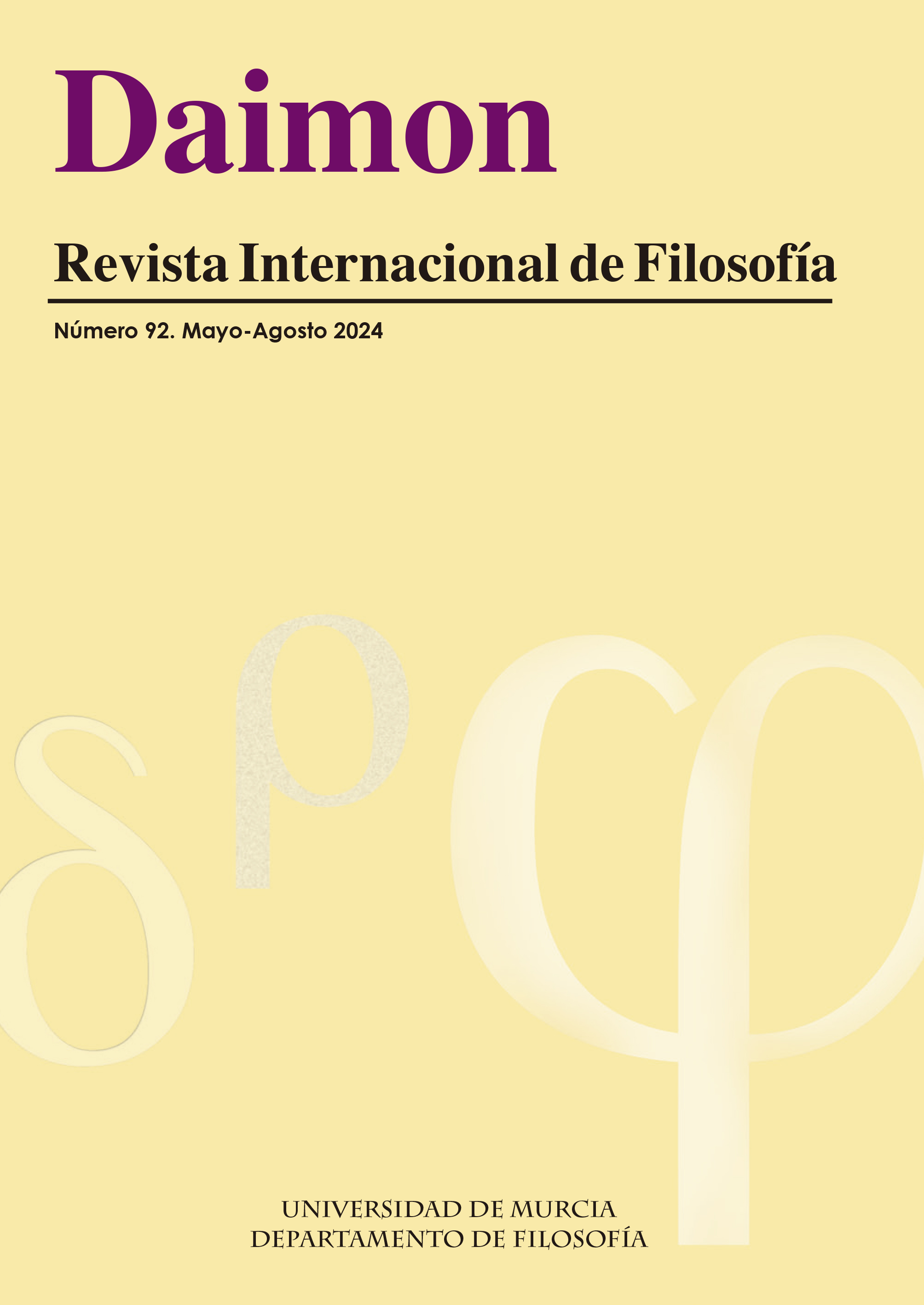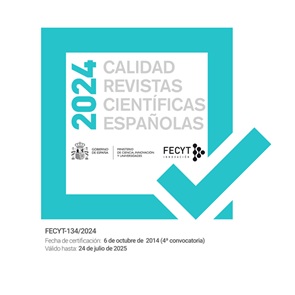El embrollo causal del naturalismo biológico
Agencias de apoyo
- Este artículo fue redactado en el marco del Proyecto de Investigación Institución y Constitución de la Individualidad (PID2020-117413GA-I00/AEI/10.13039/501100011033), del Ministerio de Ciencia e Innovación de España.
Resumen
La ontología de lo mental del naturalismo biológico depende decisivamente de la noción de causalidad. No obstante, Searle no incardina dicha noción en su ontología en diálogo con la literatura científica y filosófica relevante, sino antes bien orientado por cierta suerte de verosimilitud intuitiva. Sobre el trasfondo de la ontología general de Mario Bunge, discutimos dos importantes problemas derivados de este somero tratamiento de la causalidad: por una parte, que el emergentismo searleano se alza sobre la base de un error categorial entre propiedades y procesos; por otra, que el único argumento de Searle en favor del antirreduccionismo se encuentra en contradicción con el resto de su ontología de lo mental.
Descargas
-
Resumen460
-
PDF229
-
HTML31
Citas
Beauchamp, T. L. & Rosenberg, A. (1981), Hume and the Problem of Causation, Oxford: Oxford University Press.
Broad, C. D. (1925), The Mind and Its Place in Nature, London: Routledge.
Bunge, M. (1959/2009), Causality and Modern Science, New York: Routledge.
Bunge, M. (1977), Treatise on Basic Philosophy. Ontology I: The Furniture of the World, Dordrecht: Reidel.
Bunge, M. (1979), Treatise on Basic Philosophy. Ontology II: A World of Systems, Dordrecht: Reidel.
Bunge, M. (1980/1988), The Mind-Body Problem: A Psychobiological Approach, Oxford: Pergamon.
Bunge, M. (1981), Scientific Materialism, Dordrecht: Reidel.
Bunge, M. (2003), Emergence and Convergence: Qualitative Novelty and the Unity of Knowledge, Toronto: University of Toronto Press.
Bunge, M. (2010), Materia y mente. Una investigación filosófica, Navarra: Laetoli.
Churchland, P. M. (1996), «The rediscovery of light», Journal of Philosophy, 93, pp. 211-228.
De Landa, M. (2009), «Emergencia, causalidad y realismo», Artnodes: Revista de arte, ciencia y tecnología, 9, pp. 4-14.
Freeman, W. J. & Skarda, C. A. (1991), «Mind/brain science: Neuroscience on philosophy of mind», en: Lepore, E. y Van Gulick, R. (eds.): John Searle and his Critics, Oxford: Blackwell, pp. 115-127.
Fodor, J. A (1987), Psychosemantics. The Problem of Meaning in the Philosophy of Mind, Cambridge: MIT Press.
Jackson, F. (1982), «Epiphenomenal qualia», Philosophical Quarterly, 32, pp. 127-136.
Kim, J. (1993), «The non-reductivist’s troubles with mental causation», en: Heil, J. y Mele, A. (eds.): Mental Causation, Oxford: Oxford University Press, pp. 189-210.
Kim, J. (1998), Mind in a Physical World. An Essay on the Mind-Body Problem and Mental Causation, Cambridge: MIT Press.
Kistler, M. (2018), «Causality», en: Barberousse, A., Bonnay, D. y Cozic, M. (eds.): Philosophy of Science. A Companion, New York: Oxford University Press, pp. 95-141.
Kripke, S. A. (1980), Naming and Necessity, Cambridge: Harvard University Press.
Le Poidevin, R. (1991), Change, Cause and Contradiction: A Defence of the Tenseless Theory of Time. London: Palgrave Macmillan.
McLaughlin, B. (1993), «The rise and fall of British emergentism», en: Beckermann, A., Flohr, H. y Kim, J. (eds.): Emergence or Reduction? Essays on the Prospects of Nonreductive Physicalism, Berlin: De Gruyter, pp. 49-93.
Mellor, D. H. (1995), The Facts of Causation, London: Routledge.
Mora Teruel, F. (2001), El reloj de la sabiduría. Tiempos y espacios en el cerebro humano, Madrid: Alianza.
Nagel, T. (1974), «What is it like to be a bat?», The Philosophical Review, 83, pp. 435-450.
Nida-Rümelin, M. (2002), «Causal reduction, ontological reduction, and first-person ontology. Notes on Searle’s views about consciousness», en: Grewendorf, G. y Meggle, G. (eds.): Speechs Acts, Mind, and Social Reality. Discussions with John R. Searle, Dordrecht: Kluwer Academic Publishers, pp. 205-221.
Norton, J. (2009), «Is there an independent principle of causality in physics?», British Journal for the Philosophy of Science, 60, pp. 475-486.
Pérez Chico, D. (1999), «¿Problema? ¿Qué problema? Naturalismo biológico y el problema mente-cuerpo», Teorema, 18, pp. 125-138.
Pineda, D. (1999), «Searle y el problema de la exclusión causal. Vindicación del materialismo frente al naturalismo biológico», Teorema, 18, pp. 155-170.
Putnam, H. (1973), «Reductionism and the nature of psychology», Cognition, 2, pp. 131-146.
Sabatés, M. H. (1999), «Consciousness, emergence and naturalism», Teorema, 18, pp. 139-153.
Schaffer, J. (2016), «The metaphysics of causation», en: Zalta, E. N. (ed.): The Stanford Encyclopedia of Philosophy, Stanford: Center for the Study of Language and Information, Stanford University.
Searle, J. R. (1983), Intentionality. An Essay in the Philosophy of Mind, Cambridge: Cambridge University Press.
Searle, J. R. (1984), Minds, Brains, and Science. The 1984 Reith Lectures, Cambridge: Harvard University Press.
Searle, J. R. (1991), «Response: Perception and the satisfaction of intentionality», en: Lepore, E. y Van Gulick, R. (eds.): John Searle and his Critics, Oxford: Blackwell, pp. 181-192.
Searle J. R. (1992), The Rediscovery of the Mind, Cambridge: MIT Press.
Searle, J. R. (1995a), The Construction of Social Reality, New York: The Free Press.
Searle, J. R. (1995b), «Consciousness, the brain and the connection principle: A reply», Philosophy and Phenomenological Research, 55, pp. 217-232.
Searle, J. R. (1997a), Mind, Language and Society: Philosophy in the Real World, New York: Basic Books.
Searle, J. R. (1997b), The Mystery of Consciousness, New York: The New York Review of Books.
Searle, J. R. (1998), «How to study consciousness scientifically», Brain Research Reviews, 26, pp. 379-387.
Searle, J. R. (2000a), «Consciousness», Annual Review of Neuroscience, 23, pp. 557-578.
Searle, J. R. (2000b), «Mental causation, conscious and unconscious: A reply to Anthonie Meijers», International Journal of Philosophical Studies, 8, pp. 171-177.
Searle, J. R. (2001), Rationality in Action, Cambridge: MIT Press.
Searle, J. R. (2002), «Why I am not a property dualist?», Journal of Consciousness Studies, 9, pp. 57-64.
Searle, J. R. (2004), Mind: A Brief Introduction, New York: Oxford University Press.
Searle, J. R. (2005), «The phenomenological illusion», en: Reicher, M. E. y Marek, J. C. (eds.): Experience and Analysis, Wien: International Wittgenstein Symposium, pp. 317-336.
Searle, J. R. (2006), «What is to be done», Topoi, 25, pp. 101-108.
Searle, J. R. (2007a), «Biological naturalism», en: Velmans, M. y Schneider, S. (eds.): The Blackwell Companion to Consciousness, Oxford: Blackwell, pp. 325-334.
Searle, J. R. (2007b), «Dualism revisited», Journal of Physiology-Paris, 101, pp. 169-178.
Searle, J. R. (2009), «Biological naturalism», en: Bayne, T., Cleeremans A. y Wilken, P. (eds.): The Oxford Companion to Consciousness, Oxford: Oxford University Press, pp. 107-109.
Symons, J. (2018), «Metaphysical and scientific accounts of emergence: Varieties of fundamentality and theoretical completeness», en: Mittal, S., Diallo, S. y Tolk, A. (eds.): Emergent Behavior in Complex Systems Engineering: A Modeling and Simulation Approach, Hoboken: Wiley, pp. 3-20.
Derechos de autor 2024 Daimon Revista Internacional de Filosofia

Esta obra está bajo una licencia internacional Creative Commons Reconocimiento-NoComercial-SinObraDerivada 3.0.
Las obras que se publican en esta revista están sujetas a los siguientes términos:
1. El Servicio de Publicaciones de la Universidad de Murcia (la editorial) conserva los derechos patrimoniales (copyright) de las obras publicadas, y favorece y permite la reutilización de las mismas bajo la licencia de uso indicada en el punto 2.
2. Las obras se publican en la edición electrónica de la revista bajo una licencia Creative Commons Reconocimiento-NoComercial-SinObraDerivada 3.0 España (texto legal). Se pueden copiar, usar, difundir, transmitir y exponer públicamente, siempre que: i) se cite la autoría y la fuente original de su publicación (revista, editorial y URL de la obra); ii) no se usen para fines comerciales; iii) si remezcla, transforma o crea a partir del material, no podrá distribuir el material modificado.
3. Condiciones de auto-archivo. Se permite y se anima a los autores a difundir electrónicamente las versiones pre-print (versión antes de ser evaluada) y/o post-print (versión evaluada y aceptada para su publicación) de sus obras antes de su publicación, ya que favorece su circulación y difusión más temprana y con ello un posible aumento en su citación y alcance entre la comunidad académica. Color RoMEO: verde.











